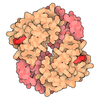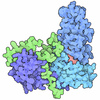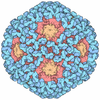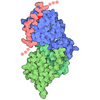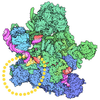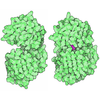[English] 日本語
 Yorodumi
Yorodumi- PDB-9q03: Cryo-EM structure of ternary complex BCL6-CRBN-DDB1 with BCL6-760... -
+ Open data
Open data
- Basic information
Basic information
| Entry | Database: PDB / ID: 9q03 | ||||||
|---|---|---|---|---|---|---|---|
| Title | Cryo-EM structure of ternary complex BCL6-CRBN-DDB1 with BCL6-760 (LDD, local refined) | ||||||
 Components Components |
| ||||||
 Keywords Keywords | LIGASE / Cereblon / BCL6 / LDD / degrader / E3 | ||||||
| Function / homology |  Function and homology information Function and homology informationnegative regulation of monoatomic ion transmembrane transport / regulation of memory T cell differentiation / negative regulation of mitotic cell cycle DNA replication / intronic transcription regulatory region sequence-specific DNA binding / negative regulation of plasma cell differentiation / negative regulation of T-helper 2 cell differentiation / negative regulation of isotype switching to IgE isotypes / isotype switching to IgE isotypes / negative regulation of mast cell cytokine production / regulation of germinal center formation ...negative regulation of monoatomic ion transmembrane transport / regulation of memory T cell differentiation / negative regulation of mitotic cell cycle DNA replication / intronic transcription regulatory region sequence-specific DNA binding / negative regulation of plasma cell differentiation / negative regulation of T-helper 2 cell differentiation / negative regulation of isotype switching to IgE isotypes / isotype switching to IgE isotypes / negative regulation of mast cell cytokine production / regulation of germinal center formation / negative regulation of mononuclear cell proliferation / plasma cell differentiation / paraspeckles / germinal center formation / regulation of immune system process / pyramidal neuron differentiation / type 2 immune response / T-helper 2 cell differentiation / positive regulation of regulatory T cell differentiation / positive regulation of cell motility / negative regulation of B cell apoptotic process / Cul4A-RING E3 ubiquitin ligase complex / negative regulation of Rho protein signal transduction / erythrocyte development / FOXO-mediated transcription of cell death genes / regulation of cell differentiation / TP53 regulates transcription of several additional cell death genes whose specific roles in p53-dependent apoptosis remain uncertain / regulation of T cell proliferation / B cell proliferation / locomotory exploration behavior / negative regulation of cellular senescence / negative regulation of cell-matrix adhesion / negative regulation of Notch signaling pathway / regulation of immune response / positive regulation of Wnt signaling pathway / negative regulation of protein-containing complex assembly / Rho protein signal transduction / positive regulation of B cell proliferation / positive regulation of neuron differentiation / regulation of cytokine production / cell-matrix adhesion / transcription corepressor binding / cell motility / positive regulation of protein-containing complex assembly / negative regulation of cell growth / chromatin DNA binding / DNA-binding transcription repressor activity, RNA polymerase II-specific / cell morphogenesis / sequence-specific double-stranded DNA binding / intracellular protein localization / heterochromatin formation / regulation of cell population proliferation / actin cytoskeleton organization / regulation of inflammatory response / Interleukin-4 and Interleukin-13 signaling / spermatogenesis / sequence-specific DNA binding / DNA-binding transcription factor binding / Potential therapeutics for SARS / proteasome-mediated ubiquitin-dependent protein catabolic process / transmembrane transporter binding / transcription by RNA polymerase II / protein ubiquitination / positive regulation of apoptotic process / RNA polymerase II cis-regulatory region sequence-specific DNA binding / DNA-binding transcription factor activity / inflammatory response / negative regulation of DNA-templated transcription / DNA damage response / chromatin binding / nucleolus / perinuclear region of cytoplasm / negative regulation of transcription by RNA polymerase II / Golgi apparatus / zinc ion binding / nucleoplasm / metal ion binding / identical protein binding / nucleus / membrane / cytosol / cytoplasm Similarity search - Function | ||||||
| Biological species |  Homo sapiens (human) Homo sapiens (human) | ||||||
| Method | ELECTRON MICROSCOPY / single particle reconstruction / cryo EM / Resolution: 3.15 Å | ||||||
 Authors Authors | Zhu, J. / Fang, W. / Pagarigan, B. | ||||||
| Funding support | 1items
| ||||||
 Citation Citation |  Journal: J Med Chem / Year: 2025 Journal: J Med Chem / Year: 2025Title: Discovery of Potent and Selective BCL6 Ligand-Directed Degrader (LDD), BCL6-760. Authors: Hunter P Shunatona / Natalie Holmberg Douglas / Jayce Rhodes / William Thomas / Diogo Da Silva / Jim Gamez / Matt Groza / Andy Christoforou / Jinyi Zhu / Scott Johnson / Dharmpal Dodd / ...Authors: Hunter P Shunatona / Natalie Holmberg Douglas / Jayce Rhodes / William Thomas / Diogo Da Silva / Jim Gamez / Matt Groza / Andy Christoforou / Jinyi Zhu / Scott Johnson / Dharmpal Dodd / Dehua Huang / Jennifer Griffin / Giulianna Miseo / Brandon Whitefield / Dahlia Weiss / James Rader / Elif Kuzu / Jim Leisten / Joselyn Del Rosario / Lihong Shi / Mary Matyskiela / Philip P Chamberlain / Peter Belmont / Matt Alexander / Christoph W Zapf / Lynda Groocock / Deborah S Mortensen /  Abstract: The discovery of a potent and selective BCL6 ligand-directed degrader (LDD), BCL6-760 () is described. Through structure-activity relationships, the most potent heterobifunctional degraders of BCL6 ...The discovery of a potent and selective BCL6 ligand-directed degrader (LDD), BCL6-760 () is described. Through structure-activity relationships, the most potent heterobifunctional degraders of BCL6 were found to be those containing short aminopiperidine linkers in combination with an indazole-based cereblon (CRBN)-binding moiety (CBM). In vitro ADME profiling of potent molecules identified BCL6-760 as an ideal molecule for use in in vivo experiments due to its good passive permeability, solubility, and microsomal stability. Mechanistic studies confirmed that BCL6 degradation is CRBN mediated, and proteomic assessment indicates a clean and selective degradation profile. BCL6-760 exhibited good oral mouse PK and was capable of penetrant and sustained PD effects. At 60 mg/kg BID dosing, BCL6-760 achieves >90% BCL6 reduction and leads to an overall 64% tumor volume reduction in an OCI-LY-1 mouse xenograft efficacy model. | ||||||
| History |
| ||||||
| Remark 650 | HELIX DETERMINATION METHOD: MOE | ||||||
| Remark 700 | SHEET DETERMINATION METHOD: MOE |
- Structure visualization
Structure visualization
| Structure viewer | Molecule:  Molmil Molmil Jmol/JSmol Jmol/JSmol |
|---|
- Downloads & links
Downloads & links
- Download
Download
| PDBx/mmCIF format |  9q03.cif.gz 9q03.cif.gz | 234.5 KB | Display |  PDBx/mmCIF format PDBx/mmCIF format |
|---|---|---|---|---|
| PDB format |  pdb9q03.ent.gz pdb9q03.ent.gz | Display |  PDB format PDB format | |
| PDBx/mmJSON format |  9q03.json.gz 9q03.json.gz | Tree view |  PDBx/mmJSON format PDBx/mmJSON format | |
| Others |  Other downloads Other downloads |
-Validation report
| Summary document |  9q03_validation.pdf.gz 9q03_validation.pdf.gz | 1.4 MB | Display |  wwPDB validaton report wwPDB validaton report |
|---|---|---|---|---|
| Full document |  9q03_full_validation.pdf.gz 9q03_full_validation.pdf.gz | 1.4 MB | Display | |
| Data in XML |  9q03_validation.xml.gz 9q03_validation.xml.gz | 31.8 KB | Display | |
| Data in CIF |  9q03_validation.cif.gz 9q03_validation.cif.gz | 46.5 KB | Display | |
| Arichive directory |  https://data.pdbj.org/pub/pdb/validation_reports/q0/9q03 https://data.pdbj.org/pub/pdb/validation_reports/q0/9q03 ftp://data.pdbj.org/pub/pdb/validation_reports/q0/9q03 ftp://data.pdbj.org/pub/pdb/validation_reports/q0/9q03 | HTTPS FTP |
-Related structure data
| Related structure data |  72086MC M: map data used to model this data C: citing same article ( |
|---|---|
| Similar structure data | Similarity search - Function & homology  F&H Search F&H Search |
- Links
Links
- Assembly
Assembly
| Deposited unit | 
|
|---|---|
| 1 |
|
- Components
Components
| #1: Protein | Mass: 16431.863 Da / Num. of mol.: 2 Source method: isolated from a genetically manipulated source Source: (gene. exp.)  Homo sapiens (human) / Gene: BCL6, BCL5, LAZ3, ZBTB27, ZNF51 / Plasmid: pMAL-c5x / Production host: Homo sapiens (human) / Gene: BCL6, BCL5, LAZ3, ZBTB27, ZNF51 / Plasmid: pMAL-c5x / Production host:  #2: Protein | | Mass: 53581.984 Da / Num. of mol.: 1 Source method: isolated from a genetically manipulated source Source: (gene. exp.)  Homo sapiens (human) / Gene: CRBN, AD-006 / Cell (production host): sf9 / Production host: Homo sapiens (human) / Gene: CRBN, AD-006 / Cell (production host): sf9 / Production host:  #3: Chemical | ChemComp-ZN / | #4: Chemical | ChemComp-A1CM7 / ( | Mass: 715.244 Da / Num. of mol.: 1 / Source method: obtained synthetically / Formula: C36H43ClN10O4 / Feature type: SUBJECT OF INVESTIGATION Has ligand of interest | Y | Has protein modification | N | Nonpolymer details | LIG DICTIONARY 94 100 Other LIG C1 C1 C 0 YNN 1 LIG C10 C10 C 0 YNN 2 LIG C11 C11 C 0 YNN 3 LIG C12 ...LIG DICTIONARY | |
|---|
-Experimental details
-Experiment
| Experiment | Method: ELECTRON MICROSCOPY |
|---|---|
| EM experiment | Aggregation state: PARTICLE / 3D reconstruction method: single particle reconstruction |
- Sample preparation
Sample preparation
| Component | Name: ternary complex of BCL6-CRBN-DDB1 with an LDD BCL6-760 Type: COMPLEX Details: BCL6 BTB domain and CRBN/DDB1 was mixed with BCL6-760 in 1:1:1 ratio Entity ID: #1-#2 / Source: RECOMBINANT | ||||||||||||||||||||||||||||||
|---|---|---|---|---|---|---|---|---|---|---|---|---|---|---|---|---|---|---|---|---|---|---|---|---|---|---|---|---|---|---|---|
| Molecular weight | Value: 0.162 MDa / Experimental value: NO | ||||||||||||||||||||||||||||||
| Source (natural) | Organism:  Homo sapiens (human) Homo sapiens (human) | ||||||||||||||||||||||||||||||
| Source (recombinant) | Organism:  | ||||||||||||||||||||||||||||||
| Buffer solution | pH: 7 | ||||||||||||||||||||||||||||||
| Buffer component |
| ||||||||||||||||||||||||||||||
| Specimen | Conc.: 4 mg/ml / Embedding applied: NO / Shadowing applied: NO / Staining applied: NO / Vitrification applied: YES | ||||||||||||||||||||||||||||||
| Specimen support | Grid material: GOLD / Grid mesh size: 300 divisions/in. / Grid type: Quantifoil R1.2/1.3 | ||||||||||||||||||||||||||||||
| Vitrification | Instrument: FEI VITROBOT MARK IV / Cryogen name: ETHANE / Humidity: 100 % / Chamber temperature: 278 K |
- Electron microscopy imaging
Electron microscopy imaging
| Experimental equipment |  Model: Titan Krios / Image courtesy: FEI Company |
|---|---|
| Microscopy | Model: TFS KRIOS |
| Electron gun | Electron source:  FIELD EMISSION GUN / Accelerating voltage: 300 kV / Illumination mode: FLOOD BEAM FIELD EMISSION GUN / Accelerating voltage: 300 kV / Illumination mode: FLOOD BEAM |
| Electron lens | Mode: BRIGHT FIELD / Nominal magnification: 130000 X / Nominal defocus max: 1800 nm / Nominal defocus min: 1200 nm / Cs: 2.7 mm / Alignment procedure: COMA FREE |
| Specimen holder | Cryogen: NITROGEN / Specimen holder model: FEI TITAN KRIOS AUTOGRID HOLDER |
| Image recording | Average exposure time: 3.16 sec. / Electron dose: 35.18 e/Å2 / Film or detector model: TFS FALCON 4i (4k x 4k) / Num. of grids imaged: 1 / Num. of real images: 10236 |
- Processing
Processing
| EM software |
| |||||||||||||||||||||||||||
|---|---|---|---|---|---|---|---|---|---|---|---|---|---|---|---|---|---|---|---|---|---|---|---|---|---|---|---|---|
| CTF correction | Type: PHASE FLIPPING AND AMPLITUDE CORRECTION | |||||||||||||||||||||||||||
| Particle selection | Num. of particles selected: 15859703 | |||||||||||||||||||||||||||
| Symmetry | Point symmetry: C1 (asymmetric) | |||||||||||||||||||||||||||
| 3D reconstruction | Resolution: 3.15 Å / Resolution method: FSC 0.143 CUT-OFF / Num. of particles: 112568 / Algorithm: FOURIER SPACE / Num. of class averages: 1 / Symmetry type: POINT | |||||||||||||||||||||||||||
| Atomic model building | Protocol: RIGID BODY FIT / Space: REAL | |||||||||||||||||||||||||||
| Atomic model building |
| |||||||||||||||||||||||||||
| Refinement | Highest resolution: 3.15 Å |
 Movie
Movie Controller
Controller


 PDBj
PDBj


